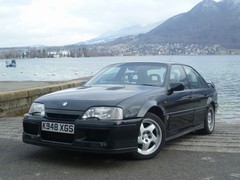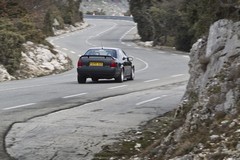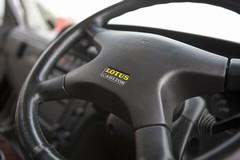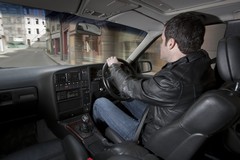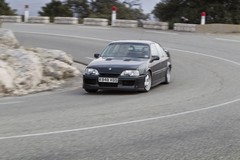Driven: Lotus Carlton
We reacquaint ourselves with a bonafide PH hero
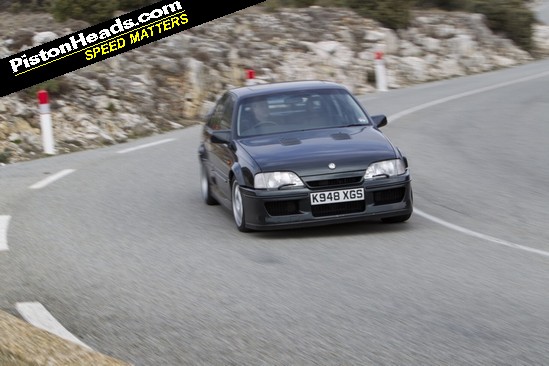
Some cars, and it's hard to pinpoint exactly why this should be, give off a peculiar blend of motoring electricity. This charged automotive current can only be felt by those susceptible to it; you've got to love cars, have a passion that makes life seem that little bit better given your exposure to them. As you're reading this on PistonHeads, there's a fair chance that you and I share this - for want of a better word - complaint.
On that basis, you'll probably understand what I mean when I say the Lotus Carlton has a small regional sub-station's worth of voltage coursing around its bodywork. It is just one of those cars. Another word for it might be shockwave - ironic, because the VXR8 parked alongside has aggressive styling termed just that: 'shockwave'. And yet, when the 'big LC' rolls quietly down the Cote d'Azur seafront and pulls up outside the rejuvenated Carlton hotel, people who care tend to only have eyes for its Imperial Green armour, and not the brash Aussie.
PistonHeads entered the Lotus Carlton into its pantheon of 'Heroes' back in 2008, so there's no point in this piece covering old ground. Many of you will know the story well: the conversation between senior management of then-GM bedfellows Vauxhall and Lotus that brought about its inception; the weapons-grade spec - the already talented Carlton GSi3000 force-fed a high-protein diet resulting in a 3.6-litre, twin-turbo 'six' producing 377bhp and 419lb ft of torque, Lotus fairy dust sprinkled over the chassis, the biggest brakes Hethel could find and a Corvette ZR1 'box - all handmade in Norfolk from a GSi delivered virtually complete.
Oh, and you'll remember the notoriety too - the 176mph top speed that sent Middle England into spasms of disapproval and made the main television news in the autumn of 1990.
So instead here are just some thoughts from someone who has dreamed about getting behind the wheel of one of these cars for a very long time, and how the driving experience feels some 21 years after the car's launch.
The Lotus Carlton tingle begins the moment your eyes see it, but it ramps up significantly when you've got that cheap, weathered, plastic key in your palm. Approach it and it's still obviously a 'big' car, in line with its once 'large executive' status, but the light, airy and yet relatively narrow cabin emphasises the common truth when comparing cars from a bygone era with their modern counterparts: that modern safety regulations and customer demands have made vehicles much larger on the outside and often slightly claustrophobic on the inside. The flipside is that those spindly A-pillars and low waistline make you keenly aware of your mortality.
The ruched black leather on the supportive chairs reminds me of the swivel furniture the parents of a school friend had in their living room, circa 1986, while the dashboard has all the grace of a Corby trouser press. You often read criticisms of the LC's interior, but the giant switchgear - you could operate it with your fist - and the cheap-as-chips analogue clock - identical to the one fitted to my Mum's 1.3-litre Astra mk1 back in 1984 - hold considerable retro appeal to a child of the 80s. And the thin, simple, 'Lotus'-scripted steering wheel must be one of the all-time great driving implements.
There are two areas where the Lotus Carlton leaves me stunned. Firstly, it's that mighty engine. It doesn't matter how much of an icon an old performance car is, appreciating it lies with expectations and mindset. Technological progress means that most of our 'legends' would be left for dead by something like a Renault Megane RS250, particularly point to point, but that doesn't mean they're any less enjoyable, or magical.
However, there's no such caveat with the LC's performance. If there's a predictably defining element to it, it's that it is epically, rudely quick. I expect some turbo lag - been warned about it, in fact - but given the age of the car I'm surprised by how little hesitation there is, especially once you've got 2500rpm showing.
Put simply, given the full beans the LC subtly pulls in a wrung-out 2011 VXR8. Once you've lit the turbos you're harnessing a spiteful surge of torque that piles on speed in fat increments and leaves my co-pilot and I giggling like idiots. If you ordered a sports saloon today and it had this level of performance you'd not be disappointed, so what on earth must it have been like back in 1990? That's the question that I can't stop asking myself for the next week or so. What must it have been like to drive a £48,000 Vauxhall with the acceleration to dismiss a Ferrari Testarossa? It just blows the mind thinking about it.
The other great surprise is the brakes. Nothing shows up an old car like braking performance, but in road driving at least, the LC's anchors are superbly effective. Less impressive is the clutch and gearbox combo, which is heavy and slow, although you do simply adapt to it. Acceleration in a Lotus Carlton is characterised by the peculiar voice of the motor - a gruff, almost 'flat' growl, appealing in tone and also felt lightly through the controls - that rises with a whine and the sound of the turbos before being stoutly punctuated by a shift up a gear so that the process can begin again.
Once off the autoroutes, the LC seems to be working in its ideal environment as we tackle the sweeping, fast roads north of the Route Napoleon. By modern standards the suspension is relatively soft, so there's a split second on corner entry when you wait for the car to adopt a stance - exacerbated by fairly slow steering: someone present who drove them when new suggests the modern tyre fitment may be exacerbating it.
We have become used with modern cars to driving with the fingertips, rarely requiring more than a half turn of lock when travelling at speed. In the Lotus Carlton you need to work the wheel more, thinking ahead and sometimes positioning your hands to 'push' the car into a corner. Again - once you're into a groove with it, you don't tend to question it too much.
Some days later I contact a friend and fellow PHer who used to own one and he's not overly complimentary about the handling. Perhaps on slower, tighter roads, or driven to the limits on a track, it could very well become a handful, and in the wet it would clearly demand a huge amount of respect. But like I said, traversing these fast, rural roads of France seems to suit it very well, and it's a privilege to be able to stretch the car's legs.
Gauging people's reaction to the LC is an amusing aspect of driving the car. As we head through an overcast and chilly France to the Swiss border, the reactions to it are split into three neat groups. There's the 80 per cent of people who simply don't acknowledge it. They might register that it's some old Vauxhall (or Opel?), and maybe that provokes a slight sneer in itself, but beyond that they have no comprehension. Then there's the 18 per cent who look genuinely insulted by its presence - the brash stance, that rear wing, the jutting chin. And then there's that remaining 2 per cent: we saw them, a life-affirming collection of double-takes, grins, waves, points, and near misses with items of street furniture. They felt the electricity, you could see that. They knew.
Personally speaking, the Lotus Carlton remains a dead cert for that extensive, barn-housed, imaginary car collection. In reality, I may never own a Lotus Carlton, perhaps scared off by the running costs and torn between other must-haves on the list and limited cash. But I salute those who put their money where their mouths are, and I know that whenever I see an LC making its way through traffic, like a shark navigating a municipal swimming pool, it'll be radiating that same old electricity.
The fact that I loved was that the Lotus engine would develop the same torque at tick-over as the 3ltr 24 valve engine it was based on could at peak rpm.
Interesting if true though - I wonder how it manages it?
I meant write obviously.

 one has to maintain one's standards.
one has to maintain one's standards.The fact that I loved was that the Lotus engine would develop the same torque at tick-over as the 3ltr 24 valve engine it was based on could at peak rpm.
Interesting if true though - I wonder how it manages it?
Not running particularly high boost to be honest at 0.7 bar
A lot of turbo engines of that time and earlier produced about 100bhp per litre running at 9/10 psi
The BMW 335i engine is a 3 litre so roughly about the same state of tune per litre if you think about it
Still the point stands - if the output per ltr is roughly the same today for say the 335i v the LC why is that the case? its 20 years on.
How about we look at say the RS6 that was a 4.2 v8 twin turbo with c450bhp, which is 107bhp/ltr.
The new RS6 is a 5.2 ltr v10 twin turbo which produces 570bhp - this equates to c110bhp/ltr
So 20 years and the improvement is a mere 10%....or less than 0.5bhp per year....
Is it a case of the LC really pushed the envalope and since that point in time no other has done it to the same level (ignore the silly bhp 2ltr WRC).
I think this is an interesting angle of debate which clearly shows the LC in even higher echelons
One thing the LC is renouned for is its in gear ability same goes for the RS6's mentioned and these all play in the same field.
Also its been 20 years fuel has been very cheap in that timeframe and only in the last 3-4 odd years have prices gone up notably.
Sure the RS6's would be quicker round the twisties but thats 4wd v rwd and more modern chassis but on the straights well there woul be nothing in it if not the LC to be ahead due to lighter kerb weight.
th old RS6 is a 4.2 ltr V8 Bi Turbo
the new RS6 is a 5.2 ltr V10 bi turbo
the new S6 is a n/a 5.2ltr v10.
The thing with the porche is that thats a coupe vs a 4 door family saloon which can seat 4 hefty rugby bruisers. So apples with apples.
However on engines alone the Porche is pushing out c140bhp/ltr so good going. What did the 911 Turbo of the day have in bhp & ltrs - just so that we ca see the progress.
However, you asked why engine tech hadn't moved on, the engine within the Porker is certainly comparable in terms of number of cylinders and and displacement. The weight of both cars is almost identical - Lotus 1663kg according to Wiki and Porsche 1660 according to their website. And the Porsche is AWD which means greater transmission losses and poorer fuel economy.
I maintain that things have moved on - considerably.
However, you asked why engine tech hadn't moved on, the engine within the Porker is certainly comparable in terms of number of cylinders and and displacement. The weight of both cars is almost identical - Lotus 1663kg according to Wiki and Porsche 1660 according to their website. And the Porsche is AWD which means greater transmission losses and poorer fuel economy.
I maintain that things have moved on - considerably.
Also - shocking that a snall coupe weighs the same as what would be a 5 series in todays money...
You said
So 20 years and the improvement is a mere 10%....or less than 0.5bhp per year.... Is it a case of the LC really pushed the envalope and since that point in time no other has done it to the same level (ignore the silly bhp 2ltr WRC).
I think this is an interesting angle of debate which clearly shows the LC in even higher echelons
...and I was stating no, engine development has advanced considerably since then.
I've never driven either car, but I would put good money on the Porsche turbo motor having much much less lag than the LC, and a much more stable power curve purely because engine electronics and turbo design has come on massively in 20 years
The 911 turbo of the LC era was the 964 Turbo
It came as a 3.3ltr turbo with 320bhp exact era as the LC which had a 97bhp/tonne
Later varients came which were the 964 Turbo S which was a 3.3ltr with 376bhp giving 114bhp/tonne
Finally the 964 Turbo was gven a 3.8ltr and 380bhp resulting in a lower 105.5bhp/tonne.
So if we take todays 997 Turbo it is a 3.6ltr which has 473bhp giving 131bhp.
Or putting it another way its circa 100bhp in absolute terms like for like.
Or it just goes to show you that todays RS6 5.2 V10 twin turbo isnt the machine it should be... it should have 681bhp.
Also the older RS6 4.2V8 twin turbo SHOULD have 490bhp not just 444bhp.
I guess only the B5 RS4 2.7 Twin Turbo delivers the business with a tasty 132bhp/ltr & thats a mighty engine.
Anyway I'm bored debating something that is clearly axiomatic - The LC engine is not the pinnacle of engine design and has been bettered many times since.
Gassing Station | General Gassing | Top of Page | What's New | My Stuff

